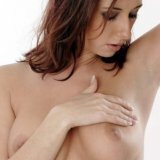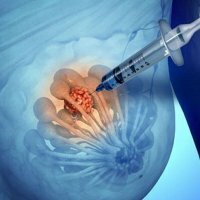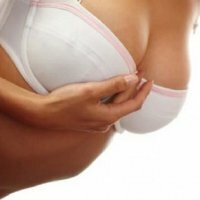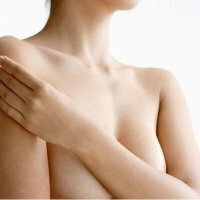Mastopathy: symptoms and treatment

Causes of mastopathy.
The cause of mastopathy is hormonal disorders, especially this is an increased level of estrogen( the female sex hormone) and prolactin( a hormone produced by the pituitary gland) and a lowered level of progesterone( the hormone of the second half of the monthly cycle).Imbalance of the hormonal background leads to the growth of the tissue( usually connective) in the mammary gland. As a result, cysts are formed.
In addition, discomfort, swelling and pain( both weak, tolerant, and very strong) in the breast are often the result of affecting the menstrual cycle.
Types and symptoms of mastopathy.
Usually distinguish diffuse and nodal kinds of mastopathy. We note in parentheses: some researchers argue that these are two stages of one process. In diffuse mastopathy, the changes are distributed relatively evenly on both mammary glands. Nodular mastopathy is characterized by formation on the background of a diffuse one or several nodes. Nodular mastopathy should be evaluated as a precancerous disease.
Diffuse mastopathy: treatment and symptoms.
Diffuse mastopathy, if it requires treatment, is treated conservatively, and nodular - conservatively and operatively( the so-called sectoral resection of the mammary gland is performed).
Diffuse mastopathy is considered the initial stage of the disease and is more common in young women. The first symptoms are swelling of the breasts and their soreness in the premenstrual period. The pain can be very strong, and the woman, thinking that she has cancer and fearing confirmation of a terrible diagnosis, does not go to the doctor for a long time. And sometimes soreness is insignificant, and the woman simply at first does not attach any importance to it. In both cases, by the time of the referral to the mammalog, the disease has already gone far enough.
In the absence of adequate therapy, pain can be amplified, given in the hand or back, interfering with normal sleep. Over time, there is a chance that the pain will subside, but a woman may begin to worry because of yellowish, transparent or bloody discharge from the nipples. To the touch, the mammary gland becomes clearly heterogeneous, the cords are felt, the lobes alternating with the granular tissue. At the end of menstruation, the breast is not completely restored.
Forms of diffuse mastopathy:
- with proliferation of intrinsic breast tissue;
- with proliferation of connective tissue;
- with formation of cysts in breast tissue;
- mixed form - diffuse fibrocystic mastopathy;
- is a form in which the gland's own tissue is replaced by a connective tissue.
Nodal mastopathy: symptoms and treatment.
Nodular mastopathy is usually observed as a continuation of diffuse and is observed in older women. The main symptom of nodal mastopathy is the appearance in the breast of one or several different in size nodes, the consistency of which does not depend on the menstrual cycle. In this case, all signs of diffuse mastopathy( cyclic changes in the mammary glands) are preserved.
It is possible to distinguish nodular mastopathy from breast cancer by using the test on the Koenig symptom. In mastopathy, the nodes are not completely palpable in the "lying" position, whereas in the case of cancer they are clearly palpable in any position of the body.
In nodal mastopathy, the nodes often contain an enlarged, altered tissue, and this qualifies as a precancerous condition. If you do not perform an operation in time to remove the nodes, a malignant tumor may appear in their place.
To prevent the development of a cancerous tumor in the mammary gland, it is necessary to diagnose and treat mastopathy in a timely manner.
Prevention and treatment of mastopathy.
Diffuse mastopathy is not always treatable. In some cases, a woman needs only to be examined regularly. The doctor prescribes treatment only with a significant deterioration in the patient's well-being: the presence of discharge from the nipples and severe pain.
Women who have been diagnosed with mastopathy should eat right - this helps normalize the hormonal background. You should eat more cereals, fruit vegetables. It is recommended to exclude from the diet all smoked, salted, and also canned. Low-fat meat( fat activates the production of estrogen) must be cooked for a couple or boil, and its total amount is as short as possible.
Very often diffuse mastopathy is provoked by a neurosis or inflammatory process of the genital organs. To prevent the further development of mastopathy, these and other diseases are diagnosed with a full medical examination of women and must be treated without fail.
Sometimes, at the initial stage of the development of mastopathy, a doctor advises a woman to have a baby and breastfeed it for as long as possible, carefully monitoring the condition of the mammary glands during the entire lactation period.
Drugs prescribed for mastopathy, mostly beneficial effect on the liver( it is there that the hormone estrogen decomposes).Corsil, Essentiale, some vitamins can restore normal liver function. It is also necessary to normalize the biliary tract.
With insufficient progesterone in the blood, a woman is prescribed to take a 0.25% solution of potassium iodide for a long time.
If the occurrence of mastopathy is due to the high level of prolactin in the blood, the doctor prescribes a homeopathic preparation of mastodinone, which also has a good effect on the work of the ovaries.
Novocaine and oxygen are beneficial for the affected gland. Novocaine removes pain, and oxygen seems to mass up the inside of the breast tissue.
Hormonal therapy is performed in accordance with diagnosed disorders of the hormonal background. With excess estrogen, the patient is assigned to receive male sex hormones. Too much prolactin is corrected with bromocriptine. Deficiency of progesterone is compensated by its synthetic analogues. Recently, the hormonal background is often normalized with the help of hormonal contraceptives.
In nodular mastopathy, surgery is shown in combination with conservative therapy, since nodular mastopathy usually develops on a diffuse background.
Sectoral breast resection involves removal of the node along with the site of the breast. This operation does not cure of diffuse mastopathy, which is then treated with conservative methods.



